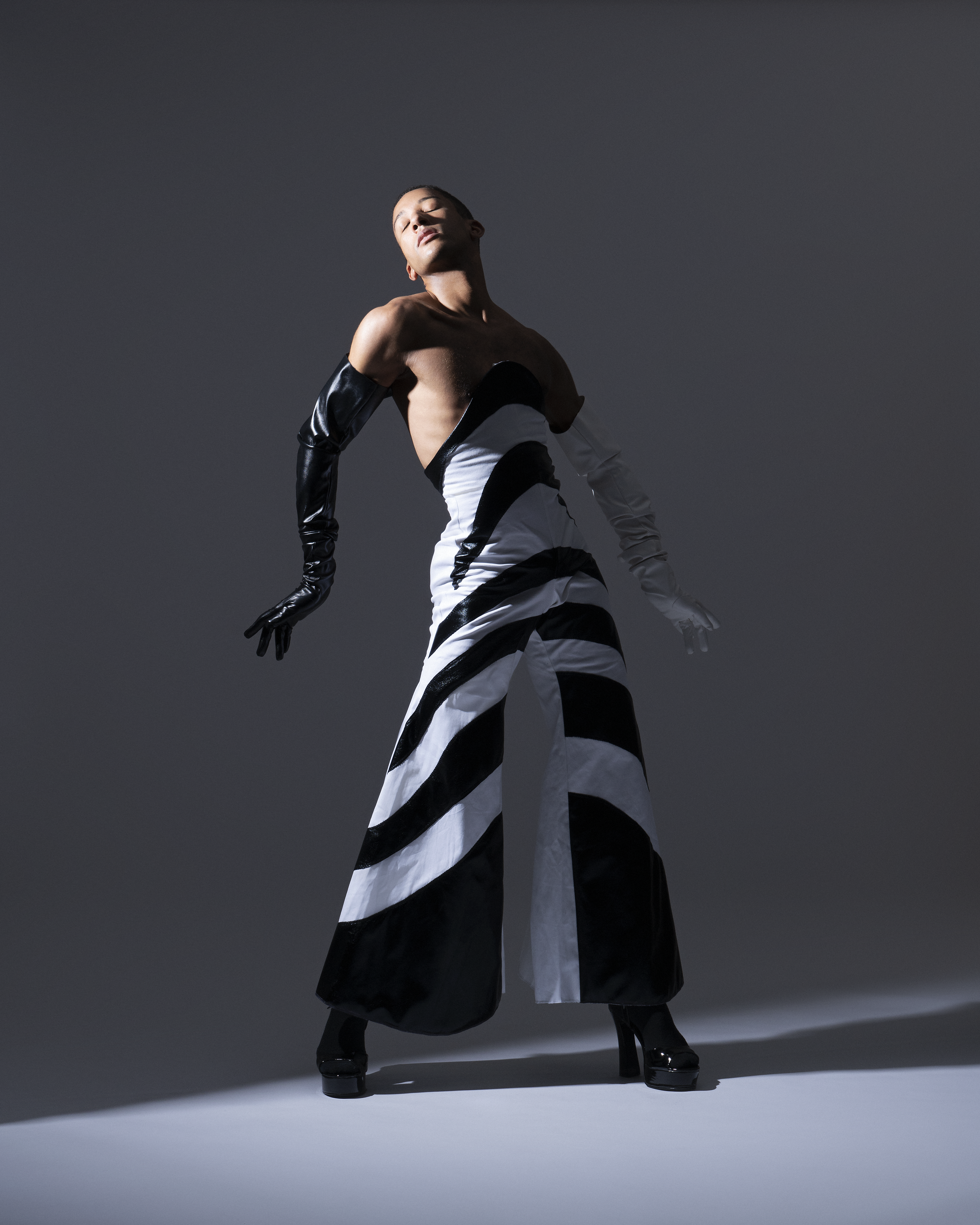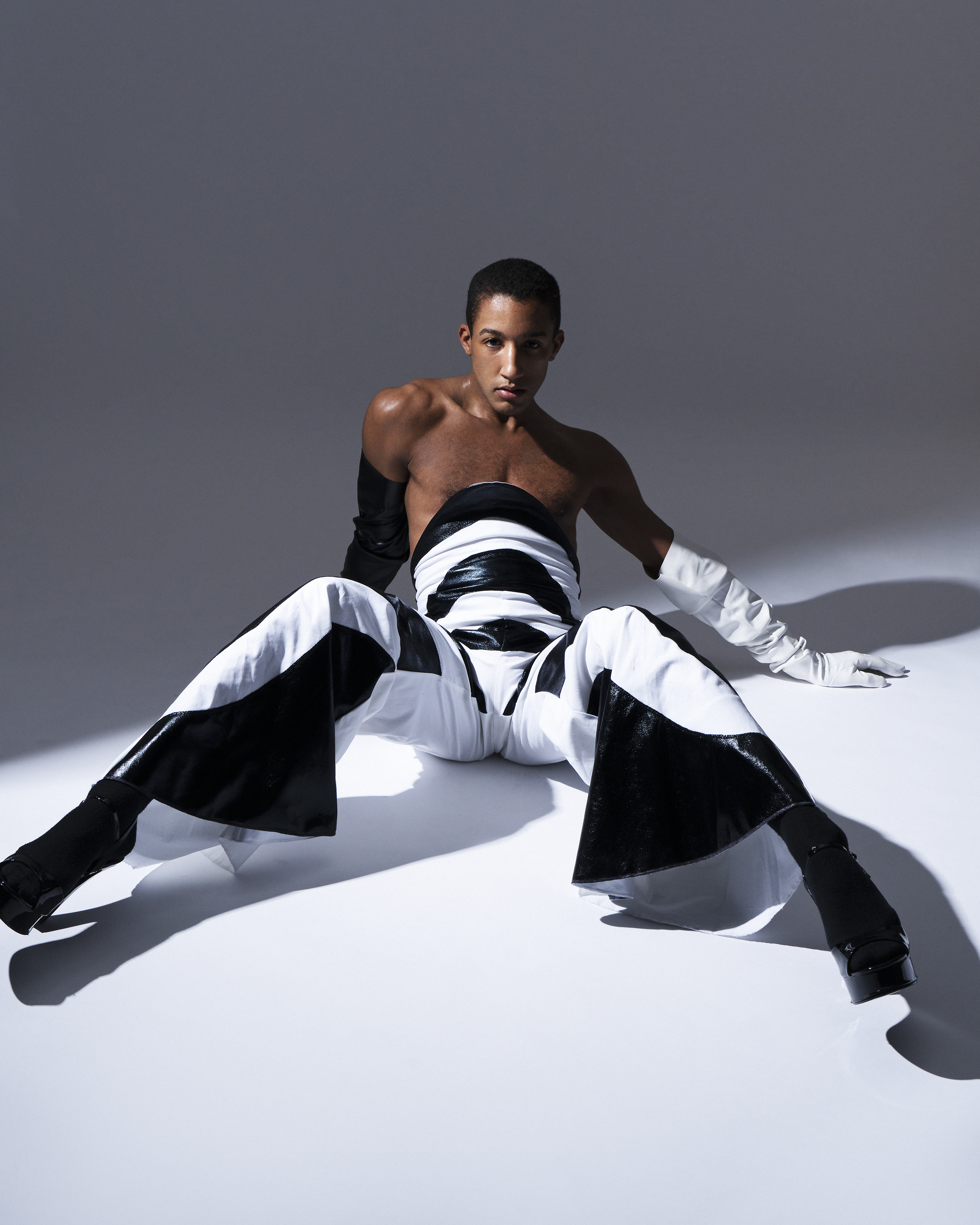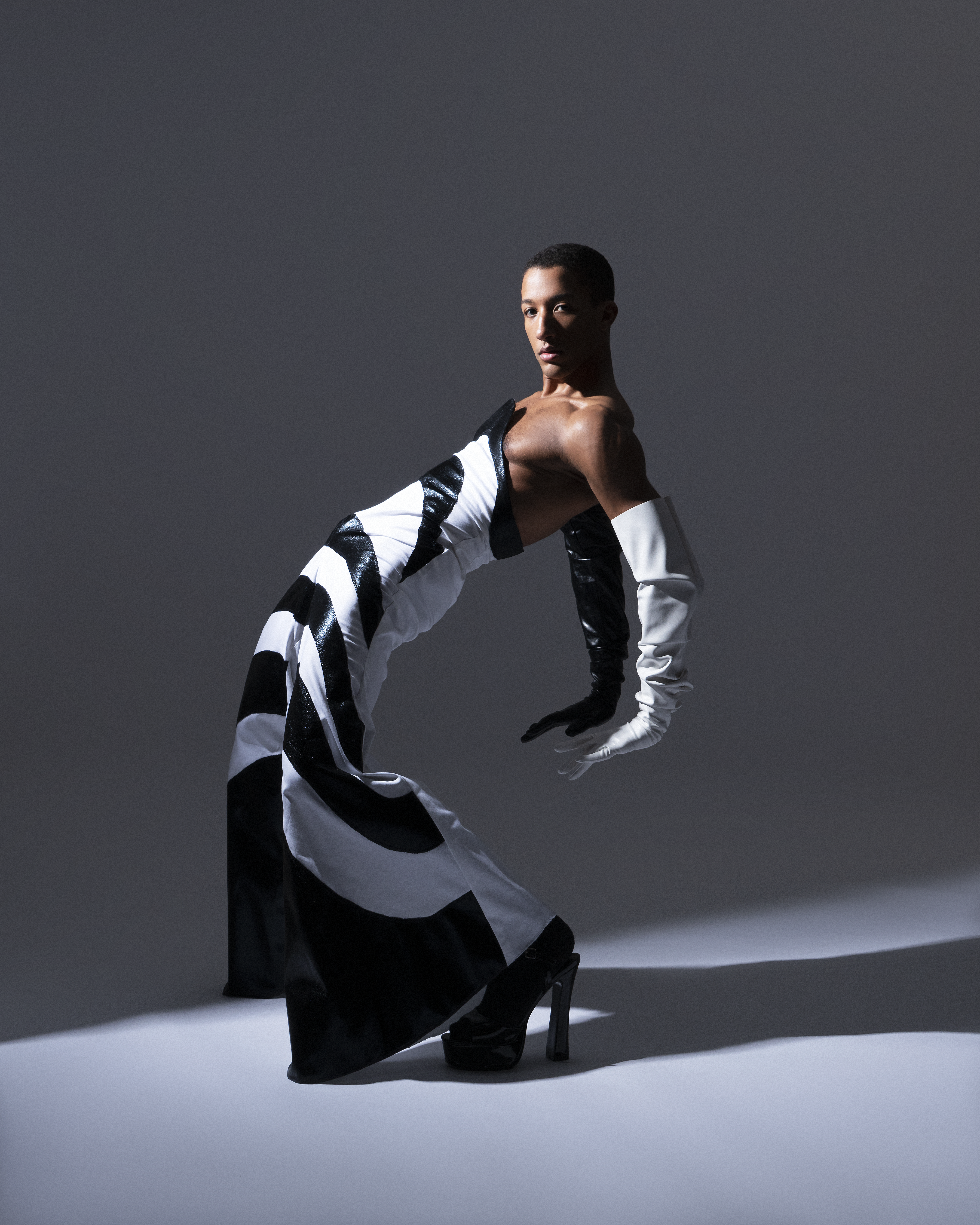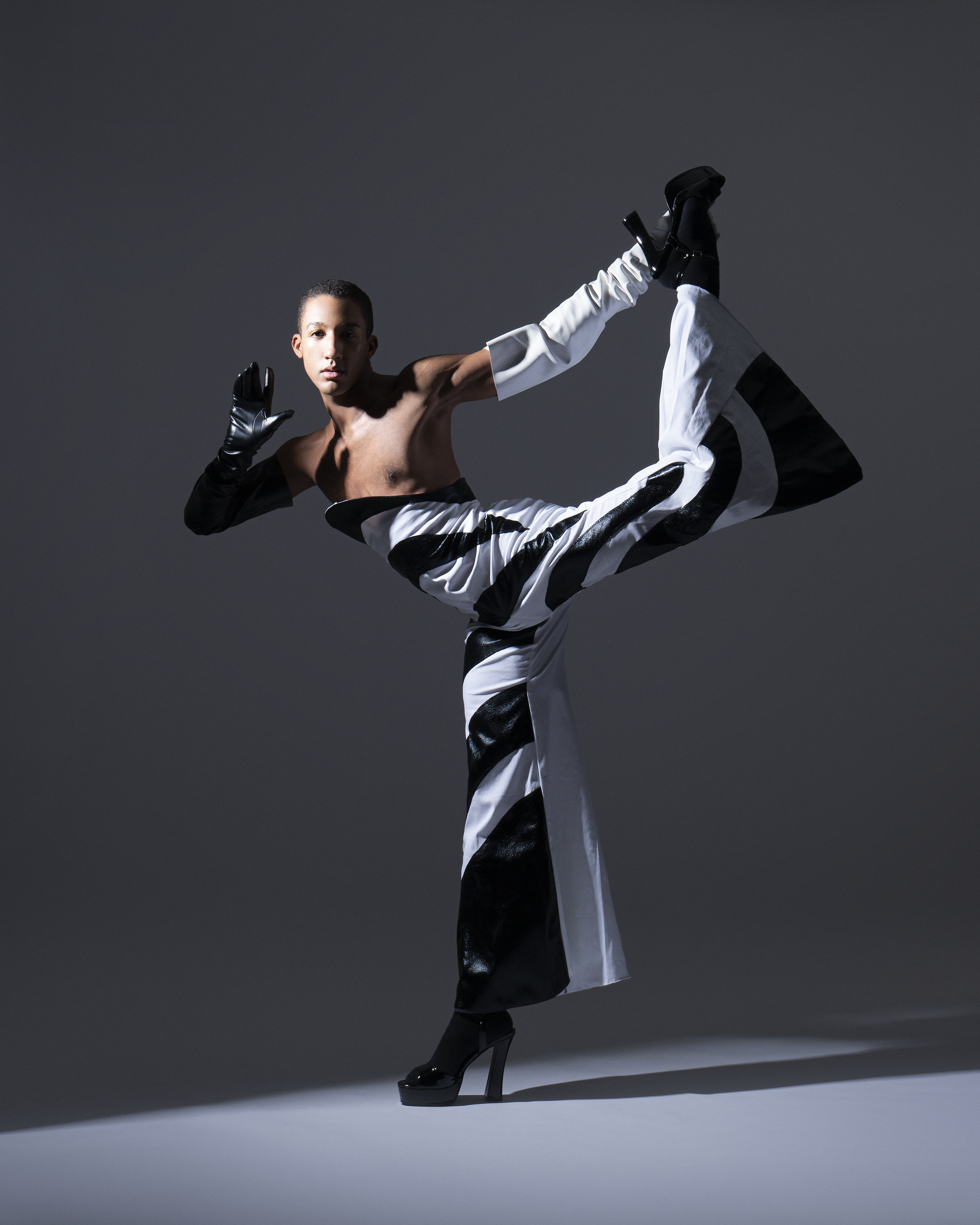Plenty of people do ballet and many others walk in heels on the regular. Yet, not many can put both together, make it art, and go viral on social media in the process. But Harper Watters can. The young dancer made waves when he posted a video highlighting his graceful abilities to not only walk in heels, but perform ballet in them too. Still, that’s just a starting point into the world of Watters.
The New Hampshire-native is the first soloist for the Houston Ballet, the first time a Black, queer person has taken on this role. It’s a position that he doesn’t take lightly. Watters understands the impact representation has on the masses. Growing up as a Black queer adoptee with white parents and in predominantly white community, seeing the Alvin Ailey Dance Theater’s collection of melanated dancers inspired a young Watters.
That same inspiration is what he hopes to provide others with his presence in the Houston Ballet and on social media via his YouTube show, The Pre-Show. That presence continues to expand. Watters has now been featured in print for Risk, Dance Magazine, and Dance Spirit, while being featured in video content for Elle, Marie Claire, and Popsugar. And with ballet taking him across the globe, more people will know Watters’ name and find themselves mesmerized by his dancing prowess.
INTO had the chance to speak with Watters about his dance journey, how he’s harnessing dance and his social media presence for good, and of course those viral videos of him walking in heels on a treadmill.

You finished your first season as the first Black queer first soloist at the Houston Ballet. You’re also the highest ranked Black person within the company. How does that feel?
Sort of a whirlwind because when we started it was really uncertain. It was really day by day, with COVID being so intense, even before the season started, we were unsure if we were even going to have a season. And so to be able to be promoted during the season, it was a real testament to the work that I put in not only to come back just physically, but also mentally, following the year of the Black Lives Matter movement and the pressure that I felt as a Black person and a Black dancer. And so it just felt like I was being rewarded for my work, but it also was a dream in a sense.
I have a level of maturity now, not just with the physical element of my dancing, but I feel like I have something to say with my dancing as well. I started to take my dancing as my advocacy and put the work into my actual dancing. And so I felt like if I took care of my dancing, I took care of myself. I did what I needed to do to make myself the best dancer I could be. That in itself is advocacy and that in itself was being part of the change and being part of what was being asked of me as a Black dancer in this company. So to be acknowledged for my hard work, I’m just extremely honored to hold this position and start this season.
You also completed your first three act ballet, Sylvia, in the principal role. What have you proven to yourself after completing that?
I danced The Prince in The Nutcracker now for about four or five years. And so I took this idea of trying to bring myself to every role and know that I have a seat at the table. I have a space on stage and what I’m doing is valid. So with this three act ballet, which was such a huge undertaking and with so much partnering, acting, and so much storytelling, I just approached it with, “How can I make this Harper and not be distracted by the people who had done the role before?”
And it didn’t happen overnight. I rehearsed the ballet for about two to three months, but to bow on stage as the last person, the principal in the role, and to lead the company forward in a one big bow as a Black person, I felt like I was a part of history and a part of a legacy that Houston Ballet has. We have a former dancer, Lauren Anderson, who was the first Black principal dancer of a major ballet company, and she still is around here working in outreach. And I very much stand on her shoulders and the shoulders of other Black queer dancers and other companies who inspired me.
And so it was an incredible experience, and it’s just a beautiful thing, what we do as the dancer, because it’s live art and you have to be in the moment and sort of just abandon yourself.
After receiving so many lessons and plenty of insight, what was the most valuable lesson you’ve learned so far in dance?
I always go back to this phrase my teacher told me when I was rehearsing. He said, “You’re never going to have the perfect wave. It’s about riding the wave you’re given”. There’s a constant push for perfection and to curate something that is of the best quality it can be. And it’s obviously great to have perfection be an inspiration to be your best, but understanding that if you’re not saying something with your dancing, if you’re not saying something with your art, if you’re not having intention behind your steps, then it sort of is just frivolous and it really doesn’t have any weight or meaning.
So even if I fall out of a pirouette, if I’m telling a story, to me that’s more valuable. I try to apply that with all my work. Even if I’m posting something on Instagram. Whether I’m saying “Look at these Black dancers who have come before me” or “Look at how fabulous I look in these heels and look at my confidence”, there’s an intensity and intention and purpose behind the things that I do. So I think that’s probably been the biggest lesson.

You give fans a behind the scenes look at ballet and show others how to effortlessly dance around a treadmill in heels via social media. Now that you have a larger social media presence, what do you hope to share with the world?
One of my favorite quotes, I don’t know if you know her, her name is Beyoncé. She has a song that is called “I Was Here” and one of the lyrics is, When I leave this earth, I’ll leave no regrets. Leave something to remember so they won’t forget I was here. A lot of the things that I do, I try to leave a lasting impact and have no regrets with what I do.
The first time I did the heels videos, one of my friends wanted to do a drag night. And this was the early stages of RuPaul’s Drag Race, which really was my first introduction to what drag was. I didn’t have Paris Is Burning. I didn’t have the ballroom scene in New Hampshire. I’m adopted and everyone was white there. So I didn’t have these cultural references. And Drag Race really was my first peer into gender bending expression. But I was so scared to just put on heels and dress up, not even as a woman because shoes are shoes, but just the fact that maybe I would be considered more feminine or that it could have an effect on my career.
I was terrified. But with my friends and all that, we were like, let’s just do it. And what happened was, beyond being super entertaining and being a viral sensation, it really was this tapping into this feeling of confidence and self expression that I wanted to inject into my dancing as a classical dancer. The more I embraced that side of me and was really like owning who I was, the posts became more colorful, they became more self-expressive, they became more fluid.
I use it for my dancing and I use my dancing for my social media that to work in tandem. And I really rely on both to be who I am. And so the heels, yes, they’re really entertaining, but it’s just one facet of who I am. It’s really fun to do. And as I get older, there’s definitely a lot more risk involved because I want to still be a successful dancer.
Sort of funny, but I have come across so many people, particularly men, who never stepped foot into a studio and they always said, “Oh, I would have loved to try dance”. I feel like by advocating for myself and doing things for myself, I’m somewhat stretched into this role of being a permission slip for people. I hope that what my message or what my lasting impact is, people do not have a regret pursuing what they want to do and listening to their gut rather than what society or other people who are ignorant.
In a previous interview, you stated that Miss J. Alexander from America’s Next Top Model was a permission slip for you to express who we are. What would you say to Miss J. if you two were to meet in person?
I mean, I would say thank you. I would say, you go to work, bitch. You are everything. But it really was this eye opening experience because I was adopted. I grew up in New Hampshire. I’m an only child, thank God. But I was forcing down what I really wanted to do.

I was obsessed with watching TRL and watching Destiny’s Child “Survivor” and “Bootylicious”. I was watching them make the music videos and I was watching Real World and watching people come together. There is a culture and there is a performance element out there that I want. But then when I saw Miss J. Alexander with legs a mile long up to his chin, serving face, serving body, and I was like, “what is that?”.
“That” is what I’m tapping into as I tucked my shirt in to become a shirt bikini to perform Destiny’s Child. Tyra is gagging for him and giving him a platform and he didn’t have to turn down who he was and what he was serving. And so that was just the first time that it really opened my eyes. It really was a wonderful moment.
You’re killing the ballet game. Where do you want to see yourself in the next few years?
Well, there are still ballets that I want to tackle as an artist and ballets that I told myself I never wanted to do out of fear or I convinced myself that I just wasn’t going to be able to do it. But performing Sylvia was really eye opening to me and was something that I was like, I accomplished it. And if I put my mind to something and I work on something and I devote my time to it, I can make it happen. So I’d say that there are more story ballets, more three act ballets that I want to dance.
There are other media platforms that I want to tackle to tell my story and to increase visibility. So whether that’s TV or whether that’s a book or I heard Wendy Williams is out of a job right now. (Queen Wendy, we love her). But a lot of what I do is trying to integrate ballet into mainstream media. Now whether or not people agree with that is up to them. But for me, I just want to increase visibility. I do believe that visibility is currency, and it doesn’t necessarily mean a monetary one.
A lot of what I do is trying to merge this world with fashion, music, books, and TV. I don’t know what that necessarily looks like, but that’s the goal. And that’s what I’m manifesting when I write in my journal every night.

Don't forget to share:
Help make sure LGBTQ+ stories are being told...
We can't rely on mainstream media to tell our stories. That's why we don't lock our articles behind a paywall. Will you support our mission with a contribution today?
Cancel anytime · Proudly LGBTQ+ owned and operated
Read More in Entertainment
The Latest on INTO
Subscribe to get a twice-weekly dose of queer news, updates, and insights from the INTO team.
in Your Inbox













